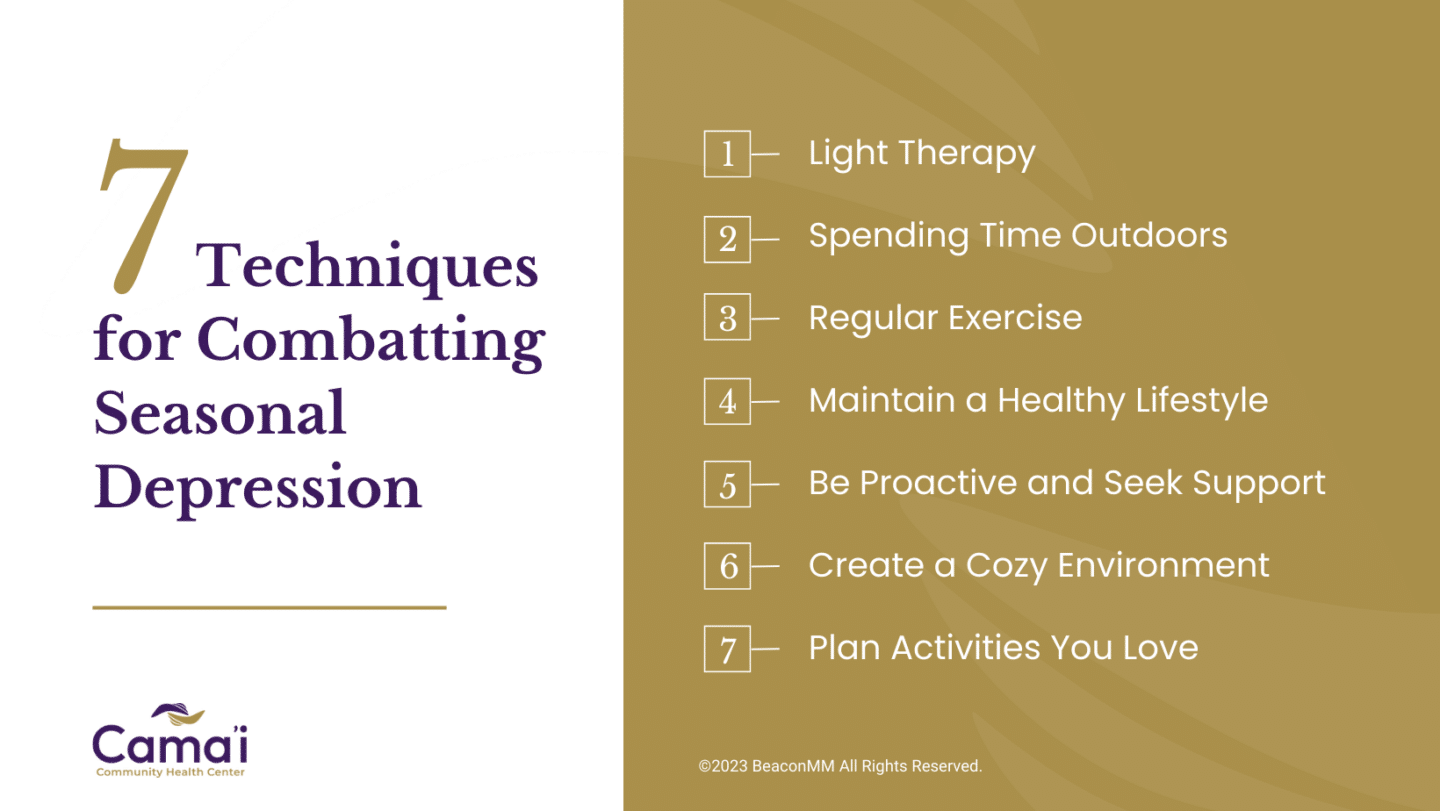Our home of Alaska is known for its breathtaking landscapes, unique culture, and extreme seasonal changes. As the winter solstice approaches, the days grow shorter and the temperatures plummet, and many residents experience a common challenge: Seasonal Affective Disorder (SAD), often referred to as the “winter blues.”
The prolonged darkness and frigid weather can significantly impact mental health, leading to feelings of lethargy, sadness, and a lack of motivation. However, there are effective strategies to combat seasonal depression and maintain mental well-being during Alaska’s long winter months.
Here, we’ll discuss how you can help manage seasonal depression in Alaska and keep your spirits up in the cold winter months.
Are you suffering from seasonal depression? Reach out to Cama’i Community Health Center today to schedule an appointment.
Understanding Seasonal Depression
Seasonal Affective Disorder is a subtype of major depressive disorder that typically occurs during specific seasons, most commonly in late fall and winter. Along with cold and flu cases spiking, in Alaska, where daylight hours drastically decrease during winter, the prevalence of SAD is notably higher. Less sunlight disrupts the body’s internal clock (circadian rhythm) and affects the production of serotonin and melatonin, neurotransmitters that regulate mood and sleep.
SAD symptoms may include:
- Depressed mood: Individuals with SAD may experience persistent feelings of sadness, hopelessness, and despair.
- Fatigue and low energy: People with winter depression often feel fatigued, have low energy levels, and may struggle to carry out normal activities.
- Changes in sleep patterns: SAD can disrupt sleep, leading to insomnia or oversleeping (hypersomnia). Changes in the body’s internal clock due to reduced sunlight can affect the sleep-wake cycle.
- Weight gain and increased appetite: Individuals with winter depression may crave and consume more carbohydrates and comfort foods, leading to weight gain.
- Difficulty concentrating: Concentration and focus can be impaired, making it challenging to complete tasks or maintain productivity.
- Social withdrawal: Feelings of sadness and low energy can lead to withdrawal from social activities, causing increased isolation and a lack of interest in usual social interactions.
- Irritability and agitation: Some individuals with SAD may experience irritability, restlessness, or increased sensitivity to stressors.
- Decreased interest in activities: Loss of interest or pleasure in activities usually enjoyed is a common symptom of depression, including winter depression.
- Feelings of worthlessness or guilt: Individuals with SAD may experience feelings of worthlessness or excessive guilt without an obvious reason.
- Thoughts of death or suicide: In severe cases, winter depression can lead to suicidal thoughts or behaviors. It’s essential to seek immediate help if these thoughts occur.
These symptoms tend to recur annually, usually starting in the fall and continuing through the winter months, and then improving in spring and summer when there is more natural sunlight.
If someone is experiencing symptoms of winter depression or SAD, it’s crucial to consult a healthcare professional for proper evaluation and treatment, which may include light therapy, counseling, medication, lifestyle changes, or a combination of these approaches.
7 Techniques for Combatting the Winter Blues

Fortunately, several strategies can help alleviate the effects of seasonal depression and improve mental well-being:
- Light Therapy: Light therapy, light box therapy, or phototherapy, involves exposure to a bright light box that mimics natural sunlight. Using a light therapy box for 20-30 minutes each morning can help regulate the body’s internal clock and improve mood.
- Spending Time Outdoors: Despite the cold temperatures, spending time outdoors during daylight hours can be beneficial. Even on overcast days, natural light exposure can have a positive impact on mood and is beneficial for vitamin D levels.
- Exercise Regularly: Regular physical activity is known to boost mood and alleviate symptoms of depression. Engage in indoor or outdoor activities like walking, skiing, or yoga to increase endorphin levels and reduce stress.
- Maintain a Healthy Lifestyle: A well-balanced diet, sufficient sleep, and limiting alcohol intake can contribute to overall mental health. Consuming foods rich in omega-3 fatty acids and vitamin D may also be beneficial.
- Seek Support: Don’t hesitate to seek professional help if symptoms of seasonal depression persist or worsen. Counseling, therapy, or support groups can provide valuable assistance and coping strategies.
- Create a Cozy Environment: Embrace the concept of “hygge” by making your living space cozy and inviting. Use warm lighting, blankets, and comforting activities to create a sense of comfort during the darker months.
- Plan Enjoyable Activities: Engage in activities that bring joy and fulfillment, such as hobbies, arts and crafts, or spending quality time with loved ones. Having things to look forward to can positively impact mood.
The Behavioral Health Approach to Treating Seasonal Depression
Seasonal depression can be treated effectively with behavioral health services through various approaches that aim to alleviate symptoms and improve an individual’s overall well-being. At Cama’i Community Health Center, we take a proactive approach to managing seasonal affective disorder — and this is especially helpful in early winter due to our remote region of Alaska.
Here are some common treatments used in behavioral health for seasonal depression:
- Cognitive-behavioral therapy (CBT): CBT is a type of talk therapy that focuses on identifying negative thought patterns and behaviors and replacing them with healthier, more adaptive ones. It helps individuals develop coping strategies to manage symptoms of depression, including those associated with SAD.
- Medication: Antidepressant medications, such as selective serotonin reuptake inhibitors (SSRIs) or other antidepressants, may be prescribed in some cases, especially for individuals with severe symptoms. These medications can help regulate neurotransmitters in the brain associated with mood.
- Lifestyle changes: Behavioral health professionals often emphasize the importance of lifestyle modifications to manage seasonal depression. This includes regular exercise, a balanced diet, ensuring adequate sleep, and practicing stress-reduction techniques like mindfulness or meditation.
- Social support and psychoeducation: Support groups or educational programs can provide valuable support and information for individuals with SAD. Learning about the disorder, sharing experiences, and receiving encouragement from peers can be beneficial.
- Mindfulness-based therapies: Mindfulness techniques, such as mindfulness-based stress reduction (MBSR) or mindfulness-based cognitive therapy (MBCT), can help individuals manage stress, regulate emotions, and improve overall well-being.
- Daily routine management: Establishing a consistent daily routine, including regular sleep patterns, meals, exercise, and social activities, can help stabilize mood and improve symptoms.
- Seasonal changes preparation: Some individuals benefit from preparing for seasonal changes by starting treatment (such as light therapy) before the onset of symptoms, anticipating and planning for their impact, and incorporating preventive measures into their routine.
Treatment plans for seasonal depression in a behavioral health setting are often individualized, taking into account the severity of symptoms, your preferences, and your response to different interventions. At the end of the day, it’s essential for individuals experiencing seasonal depression to work with mental health professionals to determine the most appropriate and effective treatment approach for their specific situation.
Trust Cama’i Community Health Center to Help You Ride Out Alaskan Winters
If you’ve started experiencing seasonal depression or are concerned about a friend or loved one in your community, it’s crucial to seek treatment or contact us. Keep in mind that seasonal depression tends to worsen during the late winter months, so being proactive in late fall is essential.
At Cama’i, our behavioral health professionals are dedicated to improving mental health among residents in our community who are dealing with depression and other mental health challenges. We understand that our remote community can sometimes hinder your access to necessary care, whether you need behavioral care for depression or other mental health issues. Remember, you don’t have to face seasonal depression alone when you have access to our services.
To help prevent seasonal depression this winter, choose Cama’i Community Health Center for your best behavioral care and treatment.
Are you or your loved one facing seasonal depression or other behavioral health concerns? Contact Cama’i Community Health Center today to speak with a behavioral health expert.


